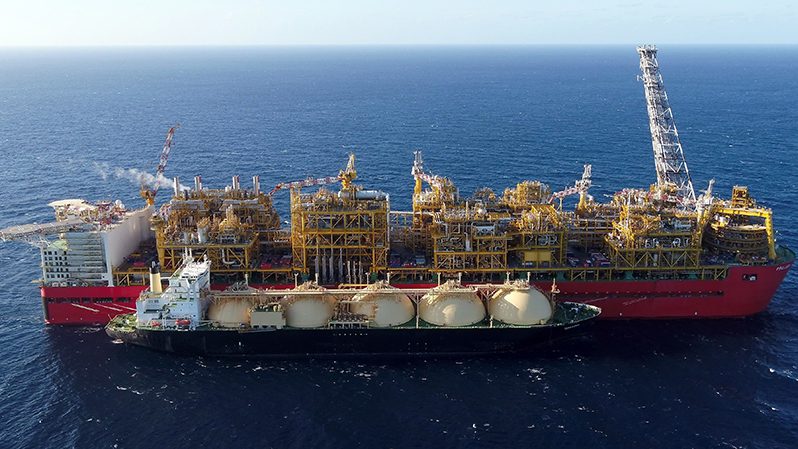In 2007, gas reserves were discovered at Prelude, followed by discovery of gas at Concerto in March 2009. It is estimated that the reserves of these fields total up to 3 trillion cubic feet. The cost of harnessing these relatively smaller wells, located in remote locations, rendered the conventional methods of laying pipeline and constructing mammoth on-shore infrastructure uneconomical. Shell proposed a floating LNG project (FLNG) which would be moored approximately 475 kilometres north-north east of Broome, Western Australia. The Australian Government approved the Prelude project in November 2010, followed by final investment decision given to the project in May 2011 and start of construction in 2012. Development of the fields was initiated in 2013 and by the end of 2014 the first well was realised.
Technip – Samsung Consortium (TSC) of South Korea was selected to construct the mammoth Prelude FLNG facility for the joint venture between Royal Dutch Shell, KOGAS and Inpex. The 488 metres long – 74 metres wide platform is the world’s largest off-shore facility ever constructed. Weighing an earth-shattering 600,000 tonnes, the structure uses over 260,000 tonnes of steel and can withstand even category 5 cyclones. The infrastructure includes 6 LNG storage tanks with a combined storage capacity of 220,000 cubic metres. In May 2014, Inpex signed heads of agreements with Tokyo Electric Power and Shizuoka Gas of Japan for supply of LNG from Prelude FLNG.
The bright red painted floating giant arrived in Australia in July 2017. In June 2018, first gas was introduced at the plant in reverse order, delivered through ship-to-ship (STS) transfer by the LNG carrier Gallina from Singapore. The facility is expected to have a life span of 25 years at its current home and is capable of delivering 3.6 MMTPA of LNG in addition to 1.3 MMTPA of condensate and 0.4 MMTPA of liquefied petroleum gas (LPG). First drops of LNG were produced from the plant in December 2018 and Shell is confident that commercial production will begin in early 2019.
The project is expected to create several Australian jobs – 150 technicians have already been trained across multiple disciplines. The facility will employ 260 local workers and create in excess of 1500 jobs during the hook-up and commissioning phase.1 The Warrmijala Murrgurlayi program aims to create 35 jobs annually, through work readiness, vocational training and job placements for Yawuru and other communities around Broome. The “Prelude to the future” apprenticeship training scheme, now in its 4th edition, has already created employment for almost 80% of the participants.2
The Prelude FLNG Environment Plan was accepted on 9th December 2016 and includes environmentally conscious and sustainable proposals for the arrival of the FLNG facility to the Browse Basin, installation and commissioning, as well as start-up, operations and maintenance of the FLNG facility and the subsea structure.3
OWNERSHIP (Equity %)
| Shell | 67.50% |
| INPEX | 17.50% |
| KOGAS | 10.00% |
| CPC Corporation | 5.00% |
General Data
| Estimated Capital Cost (USD) | 12 B |
| Plant Type | FLNG |
| Plant Stage | CSU |
| Final Investment Decision (FID) Year | 2011 |
| FEED Contractor | Technip Samsung Heavy Industries (SHI) |
| EPC Contractor | Technip Samsung Heavy Industries (SHI) |
| Commissioning | JGC Corporation |
| No. of Trains / capacity | FLNG / 3.6 MMTPA |
| Production Start Year | 2018 |
| Products | LNG, LPG, Propane, Butane and Condensate |
| Gas Type | Non-associated Gas (NAG) |
Technical Data
| Cooling Media | Seawater |
| Liquefaction Technology | APCI AP-DMR™ |
| Refrigeration Train Details: | |
| Pre-cooled Mixed Refrigerant (PMR) String | |
| Driver | GE SC1-14 Steam Turbine (60MW @ 5000 rpm) (reaction, condensing, single casing) |
| PMR Compressor | GE (Nuovo Pignone) (3BCL1100) Radially Split Centrifugal Compressor |
| Mixed Refrigerant (MR) String | |
| Driver | GE SC1-15 Steam Turbine (60MW @ 5000 rpm) (reaction, condensing, single casing) |
| Low Pressure (LP) / High Pressure (HP) MR Compressor | GE (Nuovo Pignone) (2BCL1100) Radially Split Centrifugal Compressor |
| Power Generation | 3 x Mitsubishi (MHI) 9EH-13 Steam Turbine Generators |
Refrigeration Train Configuration

Key Facts
- Australia holds an estimated 140 trillion cubic feet of stranded gas in multiple unexplored, small and remote fields. The FLNG concept was meant to economically harness such stranded gas reserves. At the time of conceptualisation oil prices were over $100 a barrel and gas supply was limited, so the high costs of construction of FLNGs were still viewed as profitable in the long term. The Technip-Samsung consortium was contracted to build multiple FLNG facilities using Shell’s proprietary technology over 15 years. However, the sharp drop in oil prices between 2014 and 2016 created an unforeseeable cost challenge for FLNGs. On the other hand, the Prelude FLNG project is almost 2 years behind schedule and its initial budget of $12.6 billion is expected to overrun to $20 billion.4,5,6,7
- Prelude FLNG uses steam for power generation and for driving several compression applications including the main mixed refrigerant and PMR compressors. It has seven boiler units supplied by Kawasaki Heavy Industries (KHI). These boilers are one of the largest capacity for marine use, and can deliver 220 tons of high-temperature and high-pressure steam per hour.8
- Steam turbines were selected as the driver for the PMR and MR compressors due to several reasons including9:
> Steam turbines have been used extensively in the marine industry
> Steam turbines require maintenance at lesser frequency compared with gas turbines
> The use of low pressure fuel gas in the steam turbines reduces the quantity of end flash gas
> Steam turbines allowed the train speed to be increased from 3600 rpm (typical of APCI plants with GE Frame 7EA gas turbines) to 5000 rpm. This resulted in a significant reduction in steam turbine size and weight. - For Prelude LNG, the steam turbine static and rotating elements have been designed to sustain hurricane pitch and roll movements. The turbine exhaust casing which is normally cast has been designed with fabricated steel to further reduce the weight, without affecting containment capability.9
- A compressor that is installed on a floating facility must withstand wind gust speeds of up to 330 km/h as well as a maximum wave height of 27.5 m (Lloyd’s Register requirement for Marine Class 1A). On Prelude LNG significant technical analysis went into the selection and design of the centrifugal compressors. This includes9:
> The mixed refrigerant (MR) compressor on Prelude LNG is a single casing, double section, back-to-back design as opposed to other similar sized LNG plants that utilize two casings for MR service. This approach significantly reduced the train length and weight. The compressor is radially split and easier to maintain as the bundle can be pulled from the side without disturbing the inlet and outlet nozzles.
> The compressors are designed to handle nozzle loads corresponding to a Category 5 cyclone. This resulted in the need for detailed casing stress evaluation and displacement checks on casing supports. - Prelude FLNG uses three 42 m, 100-tonne bollard pull Infield Support Vessels (ISV) to assist the facility. The ISVs are intended to support export activities as well as be integral to the FLNG’s emergency response and evacuation setup.10,11
- Prelude has four high pressure, high temperature dynamic flexible risers, designed and manufactured by GE Oil & Gas to remain connected and survive a 1-in-10,000-year cyclonic event. These risers are capable of drawing 50 million liters of cold water from the ocean every hour to help cool the natural gas.12,13
- The Prelude FLNG is propelled by three Rolls-Royce USL 455 azimuth thrusters. The electrically powered, 6700 horsepower thrusters fitted at the rear end of the vessel, operate two at a time, to turn the facility out of the wind and allow LNG carriers to pull alongside to load.14
- Prelude FLNG will remain permanently moored and hooked up to the undersea infrastructure for 20-25 years before docking for inspection and overhaul. The facility is held in place by 16 pre-laid, 17km long mooring chains, that are lifted from the seabed and attached to a turret built by SBM Offshore. The Turret, 100m high, weighing over 11,000 tons and with a diameter of 30m, is the largest of its kind in the world. It runs vertically through one end of the facility and is anchored to the seabed by four groups of mooring lines, allowing the facility to turn slowly in the wind, absorbing the impact of strong weather conditions, while remaining moored above the gas field.15
Source:
1. ‘Shell’s Prelude FLNG Reaches Australian Waters’, Maritime Executive Website, 25 July 2017
2. ‘Delivering Community Benefits Through Prelude To The Future’, Shell Australia Website, 3 October 2018
3. ‘Prelude FLNG Environment Plan Accepted by NOPSEMA’, Shell Australia Website, 9 December 2016
4. ‘Shell decides to move forward with groundbreaking Floating LNG’, Shell Website, 20 May 2011
5. ‘Prelude Floating Liquefied Natural Gas Facility’, Ship Technology Website
6. ‘2017 the year of FLNG, but its future isn’t so bright’, The Sydney Morning Herald website, 8 December 2017
7. ‘Delays slow Prelude’s sail-away’, The West Australia Website, 12 April 2016
8. ‘World’s Largest Off-shore Boiler Delivered’, Kawasaki Heavy Industries Website
9. Pelagotti A. et al. ‘Turbocompressor trains on first floating LNG plant’, GE Oil & Gas Website, 2013
10. ‘Steel cutting ceremony held for Prelude FLNG ISVs’, LNG World News Website, 24 September 2014
11. ‘KT Maritime names two Prelude FLNG ISVs’, LNG World News Website, 18 November 2016
12. ‘GE Oil & Gas starts production of flexible risers destined for Prelude, Shell’s landmark natural gas project’, GE Newsroom Website, 11 April 2016
13. ‘FES to Deliver Connectors for Shell’s Prelude FLNG’, Offshore Energy Today Website, 20 April 2012
14. ‘Positioning A Giant’, Rolls Royce Website
15. ‘Prelude Turret Mooring System’, SBM Offshore Website, 2016






















































